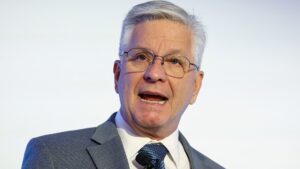The Federal Reserve’s Path Toward Lower Interest Rates: Insights from Federal Reserve Governor Christopher Waller
In the fast-paced world of economics, interest rates are a significant factor that influences everything from consumer behavior to the stock market. Recently, Federal Reserve Governor Christopher Waller made headlines with his comments about potential interest rate cuts on the horizon. His insights, delivered at a monetary policy forum in Washington, have sparked interest among economists and investors alike. At Extreme Investor Network, we believe understanding these developments is crucial for making informed investment decisions.
Anticipated Interest Rate Cut in December
Waller expressed a leaning toward supporting a cut in the policy rate at the Federal Reserve’s upcoming meeting, scheduled for December 17-18. "Based on the economic data in hand today and forecasts that show that inflation will continue on its downward path to 2 percent over the medium term," he noted, indicating a cautious optimism about the trajectory of inflation. However, he also emphasized that this decision hinges on forthcoming data. "The decision will depend on whether data that we will receive before then surprises to the upside and alters my forecast for the path of inflation," he added.
Inflation Trends: A Mixed Bag
While the prospect of lower interest rates is appealing, Waller’s remarks come with a caveat. Recent trends suggest that inflation might be stalling. The Fed’s preferred inflation indicator, the Personal Consumption Expenditures (PCE) price index, showed headline inflation creeping up to 2.3% annually, with core prices—excluding food and energy—rising to 2.8%. Given the Fed’s target of 2%, these figures indicate that the path to controlling inflation remains challenging.
In a colorful metaphor, Waller likened the struggle against inflation to an MMA fighter in a choke hold, stating, "Overall, I feel like an MMA fighter who keeps getting inflation in a choke hold, waiting for it to tap out, yet it keeps slipping out of my grasp at the last minute. But let me assure you that submission is inevitable — inflation isn’t getting out of the octagon."
Broader Economic Indicators
Despite these inflationary pressures, Waller remains optimistic about the broader health of the economy. He mentioned that even in the face of mixed signals around inflation, the economic indicators suggest an enduring strength that may warrant an easing of monetary policy. "After we cut by 75 basis points, I believe the evidence is strong that policy continues to be significantly restrictive and that cutting again will only mean that we aren’t pressing on the brake pedal quite as hard," Waller explained.
One key area he’s monitoring is employment data, which will soon be updated by the Bureau of Labor Statistics. After a disappointing job gain of just 12,000 in October, largely due to labor strikes and adverse weather conditions, stakeholders will be scrutinizing upcoming reports on job openings and nonfarm payrolls to gauge labor market strength.
The Market’s Reaction
With expectations high for a potential quarter-percentage point reduction in the Fed’s benchmark overnight borrowing rate next month, investors are left to ponder what these changes could mean for their portfolios. This anticipated move follows a 50 basis point cut in September and a quarter-point reduction in November.
At Extreme Investor Network, we encourage our readers to stay informed and prepared for the shifting landscape of monetary policy. Understanding these trends is essential for capitalizing on investment opportunities and navigating the complexities of economic cycles effectively.
Conclusion
With Federal Reserve Governor Christopher Waller’s recent insights, it’s clear that the road ahead for interest rates, inflation, and overall economic health is one of cautious optimism. As we approach the Fed’s December meeting, it’s essential to remain vigilant about the data that may influence these pivotal decisions. At Extreme Investor Network, we provide you with the resources and insights necessary to make informed investment decisions amidst these economic fluctuations. Stay tuned for further updates as we continue to analyze and interpret these significant developments.

